#Kazuma Jinnouchi
Text
Transcribed for the harp using this piano score, the main melody was fairly easy to pick up but I added some nice chords to it.
#suzume#suzume no tojimari#suzume's locking up#kazuma jinnouchi#harp#film covers#harp instrumental#anime covers
32 notes
·
View notes
Photo
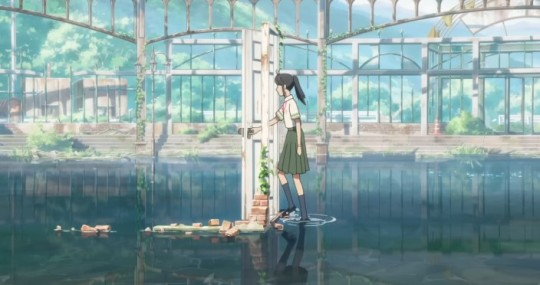
Suzume (2022, Japan)
How dramatic Makoto Shinkai’s rise has been. The Japanese animator and filmmaker, with his background in video game animation, is far away from the narrative and editing incoherence that plagued his early works, such as The Place Promised in Our Early Days (2004) and 5 Centimeters Per Second (2007). At first, neither film made viewers outside Japan take much notice. A decade later, Your Name (2016) commercially rocketed past all Shinkai films before it and, before one knew it, would go on to surpass Spirited Away (2001) as the highest-grossing anime of all time. The body-switching romantic comedy remains Shinkai’s best film, although Suzume comes much closer than I expected.
In my write-up to Your Name after its North American release, I speculated that the film’s success in Japan might be due to its allusions to the 2011 earthquake and tsunami off the coast of northern Honshu, the Tôhoku region – potentially some sort of cinematic catharsis. Though the imagery that Shinkai employed in Your Name would be unmistakable to any Japanese person who witnessed the destruction of that day, he invoked those images seemingly for the sake of aesthetic appeal. So too was this the case for Weathering with You (2019) – a film that drowned Tokyo in constant rain in service of an epochally selfish decision in pursuit of teenage romance. As such, Shinkai’s insistence to this day that Weathering with You is a film about climate change collapses entirely in the film’s finale. Suzume doubles down on Shinkai’s shtick for teen romance and obsession for how light reflects off water, but now he has made a film where the repercussions of the Tôhoku earthquake and tsunami and the subsequent Fukushima Daiichi nuclear disaster are front and center. This is his most honest film.
17-year-old Suzume Iwato (Nanoka Hara; Akari Miura as a young girl) lives with her aunt (Eri Fukatsu) on Kyūshū, the southernmost of the major Japanese islands. On the way to school one day, she passes by an attractive, long-haired fellow named Sôta Munataka (Hokuto Matsumura) who asks about local ruins. She points the way to an abandoned onsen, and – following her romantic longings rather than common sense – follows him. At the onsen, she finds a door, standing alone without supports. After she removes a totem that transforms into a cat (Ann Yamane) that scurries away, the door leads to a grassy field, with picturesque blues and reds streaking across a starlit sky. Arriving at school later, she later notices that something resembling a gigantic red worm is emanating from the door’s location. She rushes back, noticing Sôta struggling to close the door, and lends a hand to shut and lock the door – but not without the worm (which no one except these two can see) crashing to the ground and causing a sizable earthquake. Sôta explains he is a “closer” – part of a line of individuals who search for these doors and ensures that they remain shut. Failure to do so results in cataclysmic earthquakes. Against her aunt’s wishes, Suzume will follow Sôta northwards, towards Honshu. The cat, Daijin, must revert to a keystone in order to prevent further disaster.
A few decades into his film career, Shinkai’s undisciplined writing of his character’s emotions remains. Complicating everything is the fact that Daijin turns Sôta into something that should be inanimate. In interviews, Shinkai has defended this decision as the only way to have any sort of comic relief amid the film’s themes – a curious statement to make, as half of Suzume’s comedy has little to do with Sôta’s transformation, instead centering on our characters’ habits and flaws. The original plan was for Suzume to fall for another young woman, but producers nixed the idea, believing such a development too controversial for Japanese audiences*. Shinkai’s decision to make Sôta non-human puts Suzume on the brink of slapstick absurdity. Even though it remarkably allows some of the best character animation from a filmmaker not regarded for that (yes, character animation for an otherwise inanimate object), this absurdity can occasionally deprive Suzume of some much-needed pathos. Only in the Suzume’s final third does that pathos become apparent, and it arrives less powerfully than it should because of Shinkai’s decision to transform Sôta.
Combined with Suzume’s tendency to make hormone-influenced decisions during both the quieter and most perilous moments of her journey with Sôta – I am all for female characters having romantic agency, but there are times and places for when expressing or acting upon romantic feelings is appropriate – Shinkai’s teenage romantic writing can feel tactless at worst, tacky at best. Yet, because Shinkai is upfront about Suzume’s desires from the beginning (unlike the does-he-love-her-or-doesn’t-he-love-her waffling in Your Name and Weathering with You), it makes Suzume’s finale less baffling than his previous two works. Concerningly, in Your Name and Weathering with You, a natural disaster is an inconvenience to two teenagers barely realizing their love for each other. Not this time, thankfully, because of Suzume’s forwardness.
Suzume’s success comes from the tradition of live-action Japanese cinema to reflect – whether directly or otherwise – on national tragedy. When the United States ended its postwar occupation of Japan in April 1952, it also halted the censorship of topics such as the occupation itself, World War II, and other topics that the censors might object to. One could read the previous sentence and draw rash conclusions: namely, that American censorship shackled Japanese artistry. Perhaps it did, but plenty of exceptions exist, such as Yasujirô Ozu’s entire post-War filmography (even during the occupation). In Ozu’s post-War films, the families in those works quietly observe or accept the gradual Westernization of their culture, most evident in changes in nuptial and familial norms, and articulated with subtle, but great artistry. Censors have a way in sometimes making art’s politics less didactic – no less powerful, much more palatable. Now without American censors, films like Gojira (or Godzilla; 1954), Twenty-Four Eyes (1954), and The Burmese Harp (1956) wrestled with the morality of WWII, the apocalyptic consequences of nuclear weapons, and Japan’s war crimes inflicted upon its Asian neighbors (over the last few decades, Japanese filmmakers have become increasingly hesitant to engage in the last topic).
On March 11, 2011, a 9.0 or 9.1 earthquake struck off the east coast of Tôhoku. The resulting tsunami killed thousands and displaced hundreds of thousands, as well as triggering a nuclear meltdown at the Fukushima Daiichi Nuclear Power Plant. On 3/11 and the days after, images of the ocean swallowing buildings whole, boats now perched atop half-ruined rooftops, and clocks frozen at 3:25 PM made their way around a now-interconnected world. No sense can ever be made of nature’s randomness, and the loss of life in its wake. Suzume is a film that understands this, long before Shinkai truly shows what his film is about (accepting past tragedy and trauma) and what it champions (living life completely). Before we fully learn about Suzume’s loss on 3/11, Shinkai is content to introduce us to partake in some narrative detours. Those detours introduce the audience to side characters living their lives humbly, with little fanfare, and a joie de vivre. Notice the joy of the motorcycle-riding produce seller, content with the verdant beauty of her home and the rural simple living. The laid-back and unfussy Tomoya Serizawa (Ryūnosuke Kamiki; whose character is Sôta’s best friend) takes each day as is as he attempts to earn a teaching credential. Until then (and I suspect even after he becomes a teacher), he enjoys cruising along in his convertible, blasting a Spotify playlist with playful oldies such as Yumi Arai’s “Rūju no Dengon” (a familiar tune to fans of 1989’s Kiki’s Delivery Service), Yuki Saito’s “Sotsugyô”, among others.
These detours contrast with a device (that Shinkai also uses) more characteristic of Japanese cinema, or at least most Japanese cinema that has been exported to the West. That device is mono no aware (“the impermanence of things”) – with practitioners including some of the greatest Japanese filmmakers of all time such as Ozu and Isao Takahata (1988’s Grave of the Fireflies, 2014’s The Tale of the Princess Kaguya). This refers to character behaviors or individual shots that emphasize how life is fleeting and precious. In that contrast of Suzume’s loss and the joyfulness of her companions, there is an implicit understanding that Japanese culture, as our characters know it, is disappearing (one might say “transforming”). It is there in the beautifully-drawn abandoned buildings – the onsens, the schoolhouses – alluding to Japan’s demographic changes, as well as the implication that there are fewer “closers” in Japan than there used to be. For an economy once pegged to lead the future in Asia, Japan’s stagnant financial reality is reflected in the supporting cast, all of whom are hardscrabble folks neither struggling nor prospering. Sometimes that change happens suddenly, as what happened to Suzume on 3/11, leaving behind a towering sea wall and imprints of former homes as nature reclaims these once-devastated places.
The trick, Shinkai says, is to acknowledge the tragedies of the past, for all its effects on the present. At the same time, one must press forward, to live as completely as possible in the days we have afforded to us. As simple as that may be to articulate verbally or cinematically, it is a much different proposition in practice, on both counts. If Suzume presented this message inelegantly, the film would be a maudlin exercise. Touch too lightly on these themes, and the film drowns in its heavily expository dialogue. Shinkai may too fervently focus on the romantic and the comedic in spurts, but Suzume eventually upholds the film’s ultimate thesis, so that Suzume can find true happiness today and in the future while in full acceptance of her past.
youtube
With any Makoto Shinkai film post-Your Name, one expects the band RADWIMPS to score the film and provide a wealth of original songs. This time, the lone notable song is the title number, “Suzume”, and it only appears in full during the end credits, rather than the characteristic Shinkai-esque montage. Performed by RADWIMPS and featuring the TikTok singer Toaka on vocals, the sixteen-note motif in “Suzume” (even when Toaka is on vocals and not vocalizing the motif, the motif is played as the harmonic line) is a hypnotically memorable idea that serves as Suzume’s motif for the film’s entirety. Together, RADWIMPS and co-composer Kazuma Jinnouchi (Halo 5: Guardians and “The Ninth Jedi” from Star Wars: Visions; like Shinkai, Jinnouchi got his start in the video game industry) craft a gorgeous score unafraid to mix styles and instrumentations.
The action scoring as heard in “Abandoned Resort” makes full use of Japanese instruments and an ominous choir on top of orchestra – lending the scene that it accompanies an immediate tension that bolsters the sense of danger in closing the door. Similar orchestrations in the other door-closing scenes are likewise as effective as this. In other moments, a wildly jazzy “Cat Chase” sets the pace for a chaotic pursuit early in the film, all while adding to the scene’s hilarity. A simple conversation between piano and strings such as in “Time for Two” introduces secondary romantic motifs for those moments when the action slows down and Suzume has Sôta on her mind. But perhaps the most effective musical moment occurs while our two leads are in Tokyo, and Suzume makes the decision to return home in “Suzume’s Departure”. It might not be the most musically interesting cue, but RADWIMPS and Jinnouchi’s restraint to delay Suzume’s motif until absolutely necessary pays off in emotional dividends that only film music can accomplish. By some distance, this is the most beautifully scored and fascinatingly orchestrated film in Shinkai’s filmography, and a stunning achievement for RADWIMPS and Jinnouchi.
There is no doubting that Makoto Shinkai is one of the most important filmmakers in Japan at this moment. He is the figurehead for a generation of directors for whom anime has always been their foremost cultural influence – with all the strengths and substantial limitations that entails. And like those he succeeds but does not quite emulate (Ozu and his contemporaries, but more closely the likes of Hayao Miyazaki and the late Takahata), Shinkai has made a film grounded upon the aftermath of a national disaster. For the first time, those intentions and allusions are clear. The directness of feeling in Suzume is a refreshing change for him, granting the film an emotive sincerity that none of his previous works can match. Indeed, some of his expository, romantic, and comedic writing threatens to render his work as tasteless. Yet with utter conviction in his writing and filmmaking, Shinkai presents that the goodwill and kindness of others is essential following tragedy. I might take issue with Shinkai’s approach, but I have no arguments there. Following the footsteps of great directors and their films in the years after another national calamity, Suzume, though imperfect, is Shinkai at his most humanistic.
My rating: 7.5/10
^ Based on my personal imdb rating. My interpretation of that ratings system can be found in the “Ratings system” page on my blog (as of July 1, 2020, tumblr is not permitting certain posts with links to appear on tag pages, so I cannot provide the URL). Half-points are always rounded down.
* Broadly, Japanese society is not hostile towards LGBTQ+ persons. However, the nation’s politics – which have long been defined by remarkably low participation rates for an industrialized democracy, especially from younger generations – is conservative on queer rights. The ruling Liberal Democratic Party (LDP) has been in power almost continuously since its founding in 1955, and the party has always been against same-sex marriage.
#Suzume#Suzume no Tojimari#Makoto Shinkai#Koichiro Ito#Genki Kawamura#Nanoka Hara#Akari Miura#Hokuto Matsumara#Eri Fukatsu#Shota Sometani#Sairi Ito#Kotone Hanase#Kana Hanazawa#Matsumoto Hakuo II#Ann Yamane#RADWIMPS#Kazuma Jinnouchi#Toaka#My Movie Odyssey
16 notes
·
View notes
Text
Dang, this is kinda funny. I didn’t even get back into Halo until, like, late March. In all fairness though, Halo music is always great.
Don’t know how Les Champs-Elysées got 4th though. Great song, but no way I listened to it more than 1484 other songs. How dare the damn French take my #4 instead of something else from ODST.
Then there’s also my top songs playlist for anyone curious
#spotify wrapped#halo#halo infinite#michael salvatori#tally hall#zeta halo#light is green#overture#Martin O’Donnell#Les Champs-Elysées#the road#scott bradlee#Scott Bradlee's Postmodern Jukebox#vampire#team vampire#Curtis Schweitzer#Kazuma Jinnouchi#joe dassin#halo 5#halo 5: guardians#halo 3 odst#halo 3: odst#odst#Gareth Coker#spotify#french#the damn french#Spotify#top songs#music
2 notes
·
View notes
Text
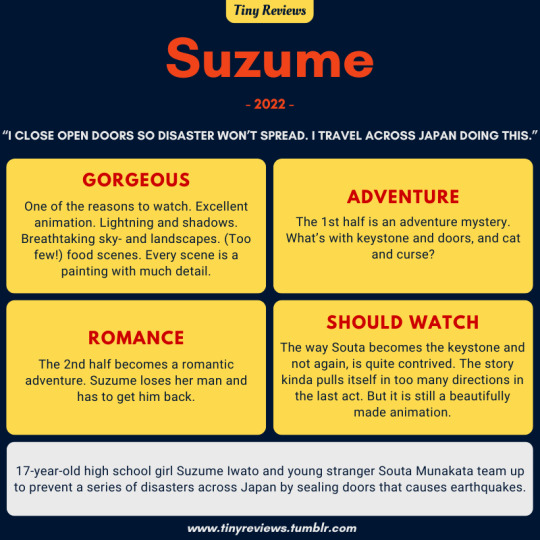
This is the middle of Your Name and Weathering With You. I m certain it would have ranked higher if it had the same repertoire of excellent songs as Your Name did.
Suzume is a 2022 Japanese animated coming-of-age fantasy adventure film written and directed by Makoto Shinkai, produced by CoMix Wave Films, and distributed by Toho.
The film features the voices of Nanoka Hara and Hokuto Matsumura, with the character designs by Masayoshi Tanaka, animation direction by Kenichi Tsuchiya, art direction by Takumi Tanji, and music by Radwimps and Kazuma Jinnouchi.
#suzume#makoto shinkai#adventure#romance#mystery#nanoka hara#hokuto matsumura#radwimps#kazuma jinnouchi#anime#movie review#anime review#2022
4 notes
·
View notes
Audio
“Violent Tactics”
by: Nobuko Toda & Kazuma Jinnouchi
from: Ghost in the Shell: SAC_2045
3 notes
·
View notes
Text
youtube
Best of 2023 Music #8: RADWIMPS and Toaka “Suzume”
ル・ル・ルルルルル・ルルル・ルルルルルル
Sam Elliot in the 2018 version of A Star is Born mentioned how music can be boiled down to 12 notes, that repeat endlessly. With only the artist that can switch things up on how the world sees the variations on those notes.
Here we focus on 7 and how it becomes intertwined within a journey.
RADWIMPS have become almost the right hand of Makoto Shinkai when it comes to his most recent films. Crafting and curating a body swapped love story, and the connections between 2 who would change things.
For Suzume they give its theme an iconic voice via those 7 infamous notes and frame a journey around it as we see how a girl and a soul within a chair go to prevent a disaster from happening.

Toakas haunting voice is what carries this.
And it’s pure magic.
SUM 22: The theme of Suzume gets its ground established via RADWIMPS backing melody and the haunting sound of Toaka giving us 7 infamous notes.
#radwimps#toaka#suzume#suzume movie#suzume iwato#suzume no tojimari#Youtube#Spotify#ル・ル・ルルルルル・ルルル・ルルルルルル#suzume x souta#makoto shinkai#best of 2023#music#8#best of 2023 music#Kazuma Jinnouchi#すずめ#すずめ; featuring Toaka
1 note
·
View note
Note
Hi!
For the 'three songs' ask set, numbers 1, 13 and 29 please <3
(If you don't mind, of course)
1. three songs that come up when you put your phone on shuffle
Venom Of Venus - Powerwolf
Witch Image - Ghost
Otherside - Red Hot Chili Peppers
13. three songs you want at your funeral
Closing the Door - RADWIMPS , Kazuma Jinnouchi
sorry but every other song I think of is a bit too cringey for funeral, even mine
29. three songs that influenced you most (some songs change or save lives)
Gimme! Gimme! Gimme! (A Man After Midnight) - ABBA
Spillways - Ghost
ZITTI E BUONI - Måneskin
All of these three started a wave of music obsession for me.
Thanks for the ask💖!
2 notes
·
View notes
Text
"Suzume" returns briefly at the Waseda Shochiku Theater
The feature film Suzume returns for a brief run at the Waseda Shochiku Theater in Tokyo, giving theatergoers another chance to see this masterpiece by Makoto Shinkai on the big screen from Saturday, January 13 to Friday, January 19.
Directed, Written, and Edited by Makoto Shinkai
Music by Radwimps & Kazuma Jinnouchi
▶︎ The Film Score Philharmonic Orchestra performs a piece from the film
On…

View On WordPress
2 notes
·
View notes
Text

29 notes
·
View notes
Text
Forward Unto Infinite Diversity and Infinite Differences
Just something for a little idea I have cooking up in my brain.
🤫
Music: Halo Canticles from the soundtrack of Halo 5 Guardians by Kazuma Jinnouchi
#Kelvin Universe#Kelvin Timeline#USS Enterprise-A#NCC-1701-A#Star Trek#Forward Unto Dawn#FFG-201#Halo#Post-Halo 3#2264#2554
7 notes
·
View notes
Text
Suzume: Preparation for the Gospel
I place this in Mary's hands for her to bring to Jesus
Mark 15:16 “And He said to them, ‘Go into all the world and proclaim the Gospel to the whole creation.’”
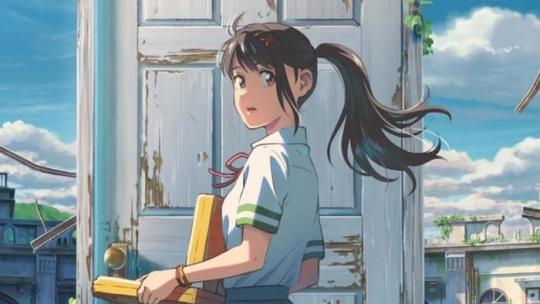
First, for those who haven’t seen the movie
a.) Background: Suzume is a 2023 anime movie written and directed by Makoto Shinkai. While it’s his third collaboration with musicians Kazuma Jinnouchi and the Radwimps, if my research is correct, it’s his 7th feature film. In other words, he’s no stranger to movie making. If you haven’t seen it or Shinkai’s other films, I’d say it’s worth a watch here’s the trailer.
b.) SPOILERS, it’s the nature of an analysis, nothing personal. If you don’t want them then go watch the movie.
c.) Premise: Like many of Shinkai’s other movies, Suzume adds a supernatural layer onto your average adolescent story. In this case, it’s an evil spirit called “the worm” that lives under Japan. Whenever it breaks into our world through certain portals – called “doors” – it causes devastating earthquakes. These doors are usually located in abandoned urban areas, e.g. the entrance door for a shutdown school, or the door of a Ferris wheel carriage at an abandoned theme park. Thankfully these gates have been kept shut throughout the centuries by a group of “Closers” who travel throughout the country shutting any gates that may pop up. Par for the course this “closing” takes the form of a spell and then using a physical key to close the door.
Our heroine, Suzume, starts the movie by unknowingly removing one of the two keystones in Japan that help keep the worm from entering our world. Luckily a young Closer, named Souta, has come to town just in time to help her closer the door. The keystone, called Daijin – a spiritual creature in the form of a cat – decides Suzume has given him a vacation, and after turning Souta into a chair and deeming him the new keystone, our feline friend takes his leave.
The rest of the movie is Suzume and Souta traveling across country to close more doors, return Souta to a human state, and get Daijin to return to his post as a keystone.

Freed from Keystone duty, Daijin takes the form of a mischievous kitten.
Second, what’s our take on all this?
Seems pretty pagan, isn’t this a Christian analysis Mr. Blogger?
Of course! And as you’ll all recall Vatican II states that “Whatever good or truth is found amongst them [those who have not yet arrived at an explicit knowledge of God] is looked upon by the Church as a preparation for the Gospel” (Lumen Gentium 16). Neither is this anything new since the phrase preparation evangelica comes down to us from Eusebius writing in the 4th century.
So how does Suzume fit into this?
I suggest the events of Suzume mirror key points of salvation history and thus prepare viewers to understand the Gospel. AND I HAVE MANY EXAMPLES!!

St. Paul preaching at Athens appealed to the mindset of his listeners. There weren’t many converts but that’s more from there own complacency than his own method.
Gospel Parallels
a. Need for a Savior
Halfway through the movie – once Suzume and Souta have gained the assistance of the other keystone guardian, named Sadaijin – we are offered this reason for all the trouble they’re going through: “to set right what has been wronged by human hands.” But what we later find out is that Suzume and Souta aren’t enough by themselves to resolve the keystone issue. They need help, and it needs to be spiritual a.k.a. divine. This is a great way to highlight the fittingness of the incarnation. Man needed to make reparation to God for his original sin, yet man was also incapable of doing precisely that. Thus, God became man so that He might do what we ourselves couldn’t do.
b. Willing self-sacrifice
Especially poignant to the story is Souta realizing he’s become the new keystone and he’ll be deprived of his human life to remained forever a keystone guardian against the worm. While you could view Souta’s sacrifice as a Christ-like one, I don’t think that does justice to the rest of the movie. His sacrifice is noted, especially by his grandfather, but it’s also pointed out that he didn’t actively will to be a keystone. Instead, he merely resigned himself to the role Daijin forced on him. The key here – no pun intended – is that it is only when Suzume proclaims that she’ll willingly offer herself up as a keystone in place of Souta that Daijin changes his mind, helps free Souta, and takes up his role as keystone once again.
This helps viewers understand that Jesus’s Passion wasn’t simply a matter of gritting His teeth and accepting divine punishment from His Father. Rather, Jesus willingly offers Himself out of love. Christ is very explicit about this when He says: “No one takes it from me, but I lay it down of my own accord. I have authority to lay it down, and I have authority to take it up again” (Jn 10:18).

It was in the context of the last supper, at the beginning of His Passion, that Jesus taught his disciples what self-gift, i.e. what true love of God and neighbor is.
c. Nature and Grace
Related to this previous point is how Daijin agrees to help Suzume after she explicitly expresses her willingness to be a keystone in place of Souta. Curiously enough, Daijin doesn’t force Suzume to keep this promise. He doesn’t even mention it. He simply responds by to it by helping her free Souta. The Gospel parallel is this: God doesn’t simply override our wills to accomplish His plan, but desires to work with us.
Another example of this mystery is how at the beginning of the movie both Suzume and Souta think Daijin is running around opening doors for the worm, but in actuality he is guiding them towards the open doors so that they can close them. He’s trying to call them to a greater service but they don’t understand and so think he’s mischievous and malevolent. Does this not call to mind God’s words in Isaiah “For my thoughts are not your thoughts, neither are your ways my ways” (Is 55:8).
d. Acts of Prayer
The formula that Souta recites to close a door references the hills and rivers of the land as gifts from the gods and how people have enjoyed life on this land but now the Closer offers those all back to the gods. Acknowledging that everything in life is a gift is not just a Christian notion, although Paul clearly articulates it one (1 Cor 4:7 What do you have that you did not receive?)But going beyond our life being a gift from God this formula shows how we are called to offer everything back to our Creator not because He’s greedy and demands it but because it helps us – in the movie it literally keeps a destructive spirit out of our life!) What comes to my mind are the beautiful words of one of the Prefaces for Mass: “For, although you have no need of our praise, yet our thanksgiving is itself your gift, since our praises add nothing to your greatness but profit us for salvation, through Christ our Lord.”

Suzume, having learned from Suota how to close a door, activates the key in her hand. If this looks intense, then know that prayer is just the same since by it we fight against the evil spirits who seek the damnation of souls.
e. Healing of memory
Finally if I can offer a more affective example it’s when Suzume meets her younger self and we finally see her internal resolution to all the emotional trauma she’s been dealing with. But I would argue this is done in an incarnational way. It’s not just don’t mentally. The movie doesn’t just have her visit here old house, or find her old notebooks. It doesn’t even pretend she’s talking to herself in her mind. It has her literally going back in time and meeting her younger self (I did say Shinkai was a fan of this stuff).
Nowadays, it’s very common for people to openly talk about their trauma, but often it’s presented as something that can’t be overcome. But this isn’t the Christian approach. Rather, it is precisely by allowing Christ to be King over all parts of our life – as well as all parts of our past – that we are no longer under the terror or fear of what has happened to us. And this isn’t accomplished by just imposing principles anachronistically. Instead, it’s by finding where and how Christ is working in that moment just as little Suzume actually encounters her older self on that cold snowy night.
Final verdict?
To close, I’ll once again recommend Suzume, but more importantly I encourage you to think about any connections you see in our culture that point to our life of faith in Christ. Don’t be afraid of being too geeky by talking about these things with friends – with respect to time and place of course e.g. not in the delivery room. My point is until we act as if our Christian faith has an influence on how we read, watch, and listen to the world around us, then we won’t have the influence on the world that we should as Christians.

One of the reasons why Mary was so effective in converting the Mexican people is that every part of her dress pointed to some native symbolism which informed the Mexican people of her role and status as the mother of God.
#catholic anime#anime analysis#animechristi#catholicism#suzume#evangelization#christian anime#overthinking
2 notes
·
View notes
Text
Another fairly straightforward piano to harp transcription using this original piano score. Once again there were some nice chord passages with this one and the main melody line was easy to pick up on!
5 notes
·
View notes
Text
RWBY: Ice Queendom Cartoons Reveals More Forged, July 3 Nippon Premiere
Masumi Asano returns as Glynda Goodwitch
The established Japanese website with regard to RWBY: Ice Queendom (RWBY: Hy? setsu Teikoku), the new television anime intended for Rooster Teeth's RWBY franchise, revealed about Friday that Masumi Asano will reprise her role because Glynda Goodwitch (seen below) inside the anime, and that the anime will best in Japan about July 3 in Tokyo MX plus BS11, and in July 5 in MBS.
Kathleen Zuelch previously voiced the character in the original English tone of voice cast. Rooster Tooth have not yet declared a language voice presenter to the character in the anime (Rooster Teeth previously declared that members from the original English throw and the Japanese dub will aceleración the roles for the anime).
Crunchyroll will stream typically the series by having an English dub and in Japanese people with English subtitles.
Rooster Teeth describes the particular anime:
RWBY: Ice cubes Queendom' presents RWBY in beautiful SECOND anime visuals. RWBY imagines a global stuffed with horrific monsters bent on passing away and destruction, plus humanity's only expect is dependent upon powerful Huntsmen and even Huntresses. Ruby Rose, Weiss Schnee, Blake Belladonna, and Yang Xiao Long happen to be four such Huntresses in training in whose journeys is going to take all of them far beyond daylight hours environment of their school, Beacon Academy. Though each may become powerful on their very own own, these 4 girls must overcome dark forces and work as some sort of team if these people truly hope to turn out to be the next era of Remnant's protectors.
Toshimasa Suzuki (Lagrange - The Blossom of Rin-ne, Typically the Price of Smiles) is directing the anime at BASE. Kenjir? Okada (March comes in such as a lion) is usually credited as main director. Gen Urobuchi (Puella Magi Madoka Magica, Fate/Zero fiction, Psycho-Pass) is traced for conceptualizing the particular anime, with Tow line Ubukata (Mardock Scramble, Psycho-Pass 2, Cat in the Cover Arise) writing in addition to supervising the intrigue. huke (Black Stone Shooter, Steins; Gate) conceptualized the character designs for the particular anime, while Nobuhiro Sugiyama (ef: the tale of reminiscences, Arakawa Under the particular Bridge, March will come in such as a lion) is designing all those characters for cartoon, while also helping as chief movement director alongside Yoshiaki Ito and Hiroki Yamamura. Nobuyuki Takeuchi (Maria Holic, Bakemonogatari) is credited with regard to visual direction. Nobuko Toda and Kazuma Jinnouchi are producing the music.
Members of the unique English cast and even the Japanese dub will reprise the roles for the cartoons (the Japanese story revealed more tone actors beyond the particular four main characters). The cast consists of:
Lindsay Jones and Saori Hayami since Ruby Went up
Kara Eberle and Con? ko Hikasa seeing that Weiss Schnee
Arryn Zech and Yu Shimamura as Blake Belladonna
Barbara Dunkelman and Ami Koshimizu as Yang Xiao Long
Hiro Shimono as Jaune Arch
Aya Suzaki while Nora Valkyrie
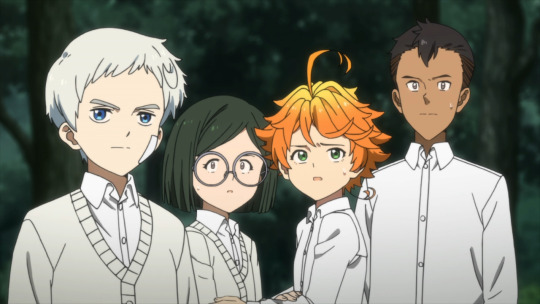
Megumi Toyoguchi as Pyrrha Nikos
S? mum Sait? as Rest Ren
Kazuhiko Inoue as Professor Ozpin
Other staff members incorporate:
Main Animators: Hiroto Nagata, Kazuki Kawada
Production Design, Extradimensional Space Design: Rui Tomono
Art Planks: Hisaharu Iijima
Artwork Director: Ken Naito
Color Key Designer: Jin Hibino
Overseer of Photography: Takayuki Aizu
Editing: Rie Matsubara
Audio Overseer: Jin Aketagawa
Producers: Bandai Namco Martial arts, Good Smile Business, Rooster Tooth
Void_Chords feat. L might perform the opening theme song "Beyond Selves. " Saori Hayami will execute the ending concept song "Awake. inch
The anime might also have a new manga adaptation simply by Kumiko Suekane (Versailles from the Dead, Blood+ Adagio, Afterschool Charisma) that will run inside of Kadokawa's Monthly Witty Dengeki Daioh mag.
Yakusoku no Neverland Gogoanime animated series by the late originator Monty Oum employs four girls together with unique weapons in addition to powers that are coaching to hunt supernatural "Creatures of Grimm. "
Bunta Kinami launched RWBY: Typically the Official Manga inside of Shonen Jump+ in December 2018, and the manga ended in June 2020. Viz Media published the particular manga as part of its Weekly Shonen Jump lineup.
Shirow Miwa drew an early on edition of the web animated series inside of Shueisha's Ultra Hop magazine from Late 2015 to Feb . 2017. Viz Mass media published the tromba in its English language edition of 7 days a week Shonen Jump mag beginning in October 2017, as well as published the manga in print out. Additionally, Viz Press is also building the RWBY manguera anthology series.
Options: RWBY: Ice Queendom's Japanese website, Comedian Natalie
7 notes
·
View notes
Text

#ProyeccionDeVida
🎬 “SUZUME” [Suzume no tojimari]
🔎 Género: Animación / Fantástico / Aventuras / Drama / Sobrenatural./Adolescencia
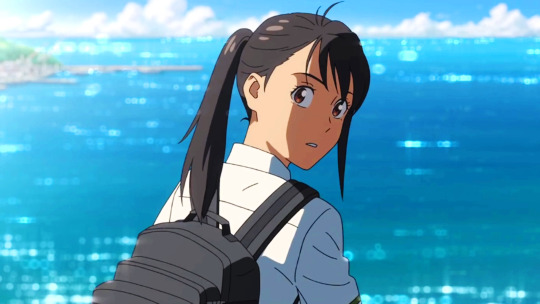
⌛️ Duración: 122 minutos
✍️ Guion: Makoto Shinkai

🎼 Música: Kazuma Jinnouchi & Radwimps
🗯 Argumento: Una joven de diecisiete años Suzume ayuda a un misterioso joven a cerrar las puertas de otro mundo, que están provocando desastres en todo Japón.
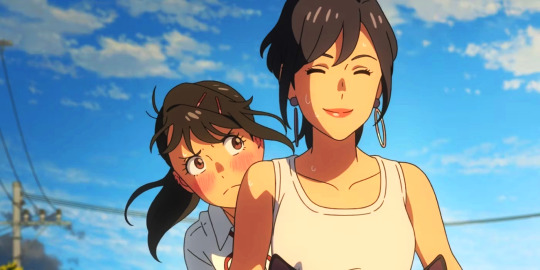
👥 Reparto: Daijin (Ann Yamane), Souta Munakata (Hokuto Matsumura), Suzume Iwato (Nanoka Hara), Tomoya Serizawa (Ryūnosuke Kamiki), Tamaki Iwato (Eri Fukatsu), Tsubame Iwato (Kana Hanazawa) y Chika Amabe (Kotone Hanase)
📢 Dirección: Makoto Shinkai

© Productoras: CoMix Wave Films, Story, Aniplex, Kadokawa, Lawson Entertainment & Voque Ting
🎞 Distribuidora: Toho
🌎 País: Japón
📅 Año: 2022

📽 Proyección:
📆 Jueves 04 de Abril
🕗 8:00pm.
🎦 Cine Caleta (calle Aurelio de Souza 225 - Barranco)
🚶♀️🚶♂️ Ingreso libre

🙂 A tener en cuenta: Prohibido el ingreso de bebidas y comidas. 🌳💚🌻🌛
0 notes
Text
Suzume no Tojimari
Wellcome friends in this article I am covering The Anime Series NamedSuzume no Tojimarifeel free to read this article and don't forget to press the follow button.
While going to class one day, Suzume Iwato incidentally finds Souta Munakata, a youthful individual searching for abandoned locales. The optional school young woman organizes Souta to a nearby ruin, `but out of pure interest, she decides to go to a comparable goal.
At that point when there, Suzume finds a separate doorway with a deceptive universe lying past it — a spot that she can see and feel, but not enter. A bizarre stone lies on the ground nearby, yet it changes into a catlike like creature and takes off when Suzume lifts it. All of a sudden fearful, she rushes toward her school, not understanding that her show of leaving the doorway open will have results.
With the "foundation" conveyed, the insidious inside the other universe can now uninhibitedly escape and release ruin all through Japan. Expecting to address her dangerous blunder, Suzume joins Souta — whose real goal is to hold fiendish back from spoiling — in finding and locking all entrances before the country is obliterated.
Suzume (Japanese: すずめの戸締まり, Hepburn: Suzume no Tojimari, lit. "Suzume's Securing") is a 2022 Japanese vivified dream experience movie composed and coordinated by Makoto Shinkai, created by CoMix Wave Movies, and disseminated by Toho. The movie includes the voices of Nanoka Hara and Hokuto Matsumura, with the person plans by Masayoshi Tanaka, movement heading by Kenichi Tsuchiya, craftsmanship bearing by Takumi Tanji, and music by Radwimps and Kazuma Jinnouchi. Suzume is Shinkai's third joint effort with Radwimps and Tanaka, after Your Name (2016) and Enduring with You (2019), and was propelled by the Tōhoku tremor and tidal wave. The film follows 17-year-old secondary school understudies Suzume Iwato and Souta Munakata, who collaborate to forestall a progression of fiascos across Japan.
The film started its creation in mid-2020, in the long run being declared as finished by October 2022. A clever transformation, likewise composed by Shinkai, and a manga series shown by Denki Amashima both appeared preceding the film's delivery.
Suzume previously debuted in IMAX in Japan on November 7, 2022, and was dramatically delivered cross-country on November 11; it was delivered globally across 2023 by Crunchyroll, Sony Pictures Delivering (under the Sony Pictures Delivering Worldwide pennant), and Wild Bundle Global. The film got positive surveys from pundits, with acclaim for its activity, characters, profound weight, and music, albeit a few commentators condemned the plot for being fundamentally like Shinkai's past movies. It has netted $298.3 million around the world, turning into the fourth-most elevated earning film of 2022 in Japan and the fourth-most elevated netting Japanese film ever.
Story Line
Suzume Iwato is a 17-year-old secondary school young lady who lives with her auntie in Kyushu. One evening, she fantasizes about looking for her mom as a youngster in a demolished area. The following morning, while setting out toward school, Suzume experiences a young fellow looking for deserted regions with entryways. She enlightens him regarding an old onsen resort close by, then follows the man herself to the hotel. Suzume finds an entryway remaining solitary on its edge, which shows a twilight field through the entryway, however, she can't enter it. She gets a feline sculpture which turns into a genuine feline and escapes. Terrified, she goes to class. At noon, Suzume sees a burst-like section emerging from the site of the onsen that no other individual can see. Returning there, she tracks down the man from previously, attempting to close the entryway. Seeing him battle and get harmed, Suzume hurries to help. They effectively close the entryway and the red section vanishes, yet not before colliding imperceptibly with the town and causing quakes like harm.
Suzume takes the man, Souta Munakata, to her home to gauze his injury. He makes sense of that he traversed Japan, finding and securing entryways in deserted spots to forestall a monster otherworldly "worm" from causing seismic tremors. The feline from the hotel shows up and transforms Souta into the kid's seat he was perched on. Souta, presently a three-legged seat, pursues the feline to a ship set out toward Ehime with Suzume following. He portrays the feline as a cornerstone, and that the worm was left after its evacuation out of close to the neglected entryway.
At Ehime, the pair use signs via web-based entertainment from local people who have captured the feline and named it "Daijin" to follow it across Shikoku. With the assistance of neighborhood inhabitant Chika, they track down the worm and close its entryway of section at an unwanted school. Following Daijin's path to Kobe because of Rumi, a neighborhood bar proprietor, the pair experience the worm reappearing at an unwanted entertainment mecca. Sōta requests that Daijin turn around into a cornerstone, however, he declines, needing to "play" with Suzume. She and Sōta lock the worm's entrance. Sōta makes sense of the entrance prompts the Always After where spirits pursue demise. As they go through the night at Rumi's bar, it is uncovered that Sōta is losing his healthy identity in his seat structure.
After following Daijin to Tokyo, Sōta has Suzume take him to his loft. He makes sense of the legend of the worm Namazu, and the way things are assuaged by the situation of two cornerstones in eastern and western Japan. The western cornerstone has turned into the feline Daijin, while records of the eastern cornerstone's area are dark. Should the worm show up in Tokyo, it could obliterate the city like the 1923 Extraordinary Kantō quake. Daijin returns and uncovers that he had given his capability as a cornerstone to Sōta's seat structure. In the wake of finding the reappeared worm, Sōta transforms into a cornerstone in Suzume's grasp, passing on Suzume to seal it away. She does so and awakens in a cavern lodging Tokyo's entryway. Looking into the Always Later, she sees the cornerstone Sōta yet again can't enter to contact him. Suzume visits Sōta's granddad at the clinic. He clarifies that Suzume's capacity to see the worm and the Consistently After through the entryways implies that she has incidentally entered the domain once previously. Besides, the entryway that she previously utilized is the main spot where she can reappear the Always Later and save Sōta.
Rejoining her Auntie Tamaki, who followed her from Kyushu, Suzume goes to her life as a youngster old neighborhood in Tōhoku, which was obliterated in the 2011 Tōhoku quake and tidal wave along with the assistance from Sōta's kindred college colleague and companion, Tomoya Serizawa whom she met at Sōta's loft just before the worm showed up in Tokyo. At a rest stop en route, Suzume finds that Tamaki was moved by Sadaijin, the eastern cornerstone. Tamaki takes Suzume to the vestiges of her old house where she once resided with her mom/Tamaki's sister, a medical caretaker who was killed in the wave. Suzume tracks down her old entryway and enters with Daijin and Sadaijin. She arises in the Consistently Later, which shows up as her town following the seismic tremor wave. While Sadaijin occupies the worm, Suzume stirs Sōta, returning him to human structure. Conceding rout, Daijin gets back to being a cornerstone. With Daijin and Sadaijin, Suzume and Sōta reseal the worm, keeping it from leaving the Always Later.
Sōta then, at that point, sees a kid in the Consistently Later: Suzume from quite a while back. Suzume recollects how she entered the Consistently After as a youngster following her mom's demise. She takes her life as a youngster seat from the Consistently After variant of her home and gives it to her more youthful self, informing her regarding her future. Youthful Suzume exits the Consistently After with the seat, prompting her to be found by Tamaki 12 years earlier. Suzume and Sōta leave the Consistently After themselves, with Sōta getting back to Tokyo while Suzume and Tamaki return to Kyushu, returning to the companions she made en route.
In a little while, back in Miyazaki, Suzume is headed to school when she by and runs into Sōta, strolling up a similar street where they initially met.
1 note
·
View note